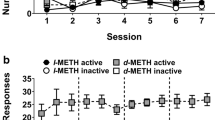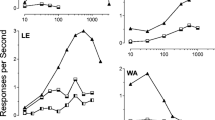Abstract
IV phencyclidine (PCP) self-administration was studied in five rhesus monkeys. The animals were given 23 h per day access with each response producing an injection. For the first seven sessions saline was made contingent on responding. For the next 30 sessions responses produced 0.01 mg/kg PCP and for the next 20 sessions responses produced 0.05 mg/kg PCP. Withdrawal signs and symptoms were evaluated every 4h during the subsequent saline-access period. All animals responded for 0.01 mg/kg injections at rates higher than their initial saline rates. Response rates decreased but total PCP intake increased during access to the higher dose. The levels of PCP self-administered resulted in severe intoxication. Evidence for physical dependence development was obtained. The symptoms emerged within 4–8h after access was terminated, peaked at 12–16h, and subsided by 24–48h. The syndrome could be reversed by IV PCP administration. The most common symptoms were vocalizations, hyperresponsivity, bruxism, oculomotor hyperactivity, and diarrhea. During withdrawal the animals refused preferred food. In some of the animals piloerection, tremors, ear and facial twitches, and priapism occurred. Rhythmic abdominal contractions and emesis were seen in one subject and convulsive activity was seen in one subject.
Similar content being viewed by others
References
Aronow R, Miceli JN, Done AK (1978) Clinical observations during phencyclidine intoxication and treatment based on ion-trapping. In: Petersen RC, Stillman RC (eds) Phencyclidine (PCP) abuse: An appraisal, N.I.D.A. Research Monograph 21, Washington, D.C.: U.S. Government Printing Office, p 218
Balster RL, Johanson cE, Harris RT, Schuster CR (1973) Phencyclidine self-administration in the rhesus monkey. Pharmacol Biochem Behav 1:167–172
Balster RL, Pross RP (1978) Phencyclidine: A bibliography of biomedical and behavioral research. J Psychedelic Drugs 10:1–15
Deneau G, Yanagita T, Seevers MH (1969) Self-administration of psychoactive substances by the monkey. Psychopharmacologia 16:30–48
Downs DA, Harrigan SE, Wiley JN, Robinson TE, Labay RJ (1979) Continuous stimulant self-administration in rhesus monkeys. Res Commun Psychol Psychiat Behav 4:39–49
Johanson CE, Balster RL, Bonese K, (1976) Self-administration of psychomotor stimulant drugs: The effects of unlimited access. Pharmacol Biochem Behav 4:45–51
Lin DCK, Fentiman F, Jr, Foltz RL, Forney RD, Jr, Sunshine I (1975) Quantification of phencyclidine in body fluids by gas chromatography chemical ionization mass spectrometry and identification of two metabolites. Biomed. Mass. Spectrom. 2:206–214
McCarthy DA, Jr, Harrigan SE (1976) Dependence-producing capacity of ketamine in Macaca mulatta. In: Proceedings of the Sixth World Congress of Anaesthesiology. Exerpta Medica, 160–168
Moreton JE, Meisch RA, Stark L, Thompson T (1977) Ketamine self-administration by the rhesus monkey. J Pharmacol Exp Ther 203:303–309
Petersen RC, Stillman RC (eds) (1978) Phencyclidine (PCP) abuse: An appraisal. N.I.D.A. Research Monograph 21, Washington, D.C.: U.S. Government Printing Office
Pickens R, Thompson T, Muchow DC (1973) Cannabis and phencyclidine self-administration by animals. In: Goldberg L, Hoffmeister F (eds) Psychic dependence, Springer: Berlin-Heidelberg-New York p 78
Winger GD, Woods JH (1973) The reinforcing property of ethanol in the rhesus monkey. Initiation, maintenance and termination of intravenous ethanol-reinforced responding. Ann NY Acad Sci 215:162–175
Wirth PW, Crowder WF, Bedford JA (1977) A low-force swivel connector for infusing liquids into unrestrained animals. Behav Res Methods Instrumentation 9:265–266
Yanagita T, Takahashi S (1970) Development of tolerance to and physical dependence on barbiturates in rhesus monkeys. J Pharmacol Exp Ther 172:163–169
Author information
Authors and Affiliations
Rights and permissions
About this article
Cite this article
Balster, R.L., Woolverton, W.L. Continuous-access phencyclidine self-administration by rhesus monkeys leading to physical dependence. Psychopharmacology 70, 5–10 (1980). https://doi.org/10.1007/BF00432363
Received:
Accepted:
Issue Date:
DOI: https://doi.org/10.1007/BF00432363




